As I'm on a pretty tight budget, I'll be hoping not to spend too much on food. No fancy dinners for me this time. (Sigh) With this in mind, I've been researching costs for various things including food/meals and found some really good info. I know if I write it down on a piece of paper or type it in a word document, I'll either lose it or forget it, so posting it here is a good way to not forget. Plus, it might help others.
Malebranche Matcha Biscuits - only at Kyoto . It comes in a special metal box only found at the Kiyomizu-dera branch.
One important reminder though, when buying such food items, you have to buy them towards the end of the travel because most Japanese pastries and confectionary expires within 1-2 weeks. (Damn, I'm going to Kyoto in the first part of my trip!)
Although my rule of thumb when purchasing stuff in Japan is to turn around the item and check for this label : “日本製“. Expectedly, you will find that products with this label will be about 20-50% more expensive than say the China-made ones.
Eat at Japanese fast food restaurants
Japanese fast food restaurants are never out of sight in Tokyo. They are of course not the healthiest option around, but they serve delicious, safe, authentic Japanese food that is both satisfying and wallet-friendly – exactly what we need on a budget holiday.
To eat: Beef bowl (gyu-don)
Price: From 290yen/regular bowl or 400yen/set (includes miso soup and pickles)
Where: Sukiya, Matsuya, Yoshinoya
Extra tip: Sukiya and Matsuya’s beef bowls are offered in 4 different portions: mini, regular, large and extra large. If there are two of you, ordering the large (from 390yen) or extra large (from 500yen) bowl will most likely work out to be cheaper.
To eat: Tempura on rice or with noodles
Price: From 500yen/set (includes miso soup)
Where: Tendon Tenya
To eat: Soba and udon noodles
Price: From 270yen/bowl or 500yen/bowl with a mini bowl of rice with deep fried pork cutlet with egg and onion (katsudon)
Where: Fuji Soba
Extra tip: Soba and udon noodles are perfect regardless of the season as you can order them either warm (atatakai) or cold (tsumetai).
To eat: Bento boxes with various dishes
Price: From 390yen/box (rice with meat and salad)
Where: Origin Bento, Hotto Motto
Extra tip: Some of these bento houses are open 24/7, allowing you to satiate your hunger at any time of the day.
Want Western Food?
Where: MOS Burger, Lotteria and Freshness Burger for burger; First Kitchen, Saizeriya and Gusto for burger, pizza and pasta.
The average cost of a bowl of ramen even in hole-in-the-wall establishments is 750yen. Look out for lunch deals though – in places such as Shinjuku and Shibuya where office workers and students congregate, there tend to be “one coin” lunch promotions on weekdays. Meaning, lunch is for only 500yen! What more, some ramen shops offer free upsizing of noodles. Be sure to ask for it (o-mori)!
Other than fast food chain restaurants, convenience stores such as Lawson, Family Mart and 7 Eleven are your best bet on cheap food. Rest assured that their quality and taste are not compromised. For a quick breakfast, pick a rice ball (onigiri) or two for as low as 108yen each! There are also bento boxes for those with a larger appetite. Sandwiches, bread and Chinese pork/chicken buns can also be bought. Try the pizza bun for a twist of Chinese and Italian flavours. For an occasional indulgence, try the spicy chicken cutlet at Family Mart.
ENJOY FREE ATTRACTIONS
Where: Shinjuku
What to do: Go to Takashimaya basement for free food samples. Check out an unobstructed view of the entire Tokyo city and if you’re lucky, Mount Fuji, from the Tokyo Metropolitan Government Building.
Where: Yoyogi/Harajuku
What to do: Visit Yoyogi Park and the nearby Meiji Shrine, followed by a stroll down Takeshita Street (where you can find Harajuku crepe) and Omotesando Street.
Extra tip: Go on a weekend to see buskers performing all kinds of acts in Yoyogi Park. On Sundays in particular, you will see Gyaru and Lolita fashionistas sashay their way down Takeshita Street as wide-eyed tourists look on. They will usually say yes to pictures.
Where: Shibuya
What to do: Check out the latest Japanese fashion trends at Shibuya 109 – there are separate buildings for men and women. Observe the famous Shibuya crossing from the 2nd-floor Starbucks opposite the train station (you don’t have to buy anything). Take pictures with the statue of Hachiko, the loyal dog.
Where: Ueno
What to do: Picnic at Ueno Park. Busk in old Tokyo vibes down Ameyoko Street.
Extra tip: Get your souvenir-shopping (read: green tea KitKats and wasabi peas) done for cheap at Niki no Okashi (二木の菓子) on Ameyoko Street.
Where: Tokyo Station
What to do: See and take pictures of Tokyo Station’s new façade. Cycle around Tokyo Imperial Palace for free on Sundays, or simply wander around the garden.
Get WiFi for free
McDonalds and Starbucks in Tokyo do not provide free WiFi services. Fortunately, the frustrated cries of all tourists have been heard. Present your passport upon arrival at Narita Airport to register for free WiFi at more than 45,000 hotspots across eastern Japan for up to 14 days! For more information, visit the official website.
Say NO to shopping!
It takes quite a bit of self-discipline, but it’s all part of the Art of Budget Travelling. Unless it’s DAISO and it’s something you absolutely, definitely, certainly cannot find at home or is too cute to resist (we can always cut some slack for some kawaii cosmetics and cool electronic gadgets, can’t we?), put it down and walk away. Your cost-conscious alter ego will thank you for that later.
That being said, if you absolutely need to buy anything – from toiletries to stationery – just hit the nearest 100 Yen store. Food, however, is still cheaper in supermarkets and convenience stores. There are plenty of 100 Yen shops dotting Tokyo, but DAISO remains an edge above the rest in offering superior quality products, making it a good place to shop for souvenirs too. Don’t be misinformed, though – items in 100 Yen shops are in fact 108yen, not 100yen, after tax.
Another good place to shop for cheap bargains is Don Quijote (simply, “don-ki”) where you can find literally everything under the sky. Snacks, instant noodles, heat packs, iPhone chargers, medicine, cosmetics, underwear, anime costumes, porn? You name it, they have it.
One of the comments said there's a free "tourist train" at Shibuya where they are also very helpful with information.
The above information (apart from my two cents worth), has been used with permission and is from TripZilla Magazine by Lee Shu Shien.
Melbourne time
Hello, こんにちは Kon'nichiwa
Well hello, Kon'nichiwa, or should I say こんにちは.....
This blog is about my trip to Japan later on this year. The countdown has begun, today is Easter Sunday, 27 March, I fly to Japan in 70 days, 5 hours and 10 minutes! I know three words in Japanese - hello, thank you and goodbye. I don't drink beer and I don't like raw fish. But I love meeting people, seeing new places, culture and history. I will only pass this way but once and I feel the need to try and see as much as I can in as little time as I have. .
This blog is about my trip to Japan later on this year. The countdown has begun, today is Easter Sunday, 27 March, I fly to Japan in 70 days, 5 hours and 10 minutes! I know three words in Japanese - hello, thank you and goodbye. I don't drink beer and I don't like raw fish. But I love meeting people, seeing new places, culture and history. I will only pass this way but once and I feel the need to try and see as much as I can in as little time as I have. .
Cheers. 乾杯









No comments:
Post a Comment